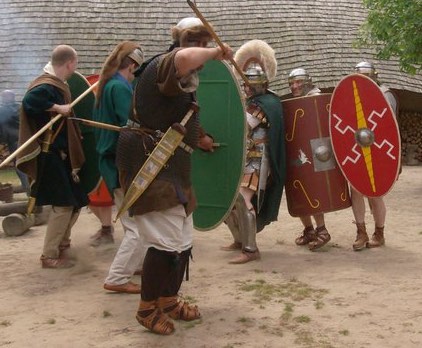Ancients wargaming, verse 3

Record of a unique event - with nary a uniform reenactor anywhere
The following is likely an altogether familiar problem if you're a reenactor or wargamer, a historical illustrator, or a publisher of a magazine like Ancient Warfare for that matter. It's the problem of translating fragmented narrative and archaeological sources into a concrete, complete re-creation of a person from antiquity. At some point, you're going to have to make decisions about dress, equipment, colors, and everything else. You can't reenact, say, a third-century Roman triarius without deciding whether you're going to wear the traditional Apulo-Corinthian helmet or not. The tunic of your Macedonian minis will have to be painted some color (yes, I'm in the school that minis should always be painted to see the table), and we can't leave something out of an illustration just because we don't have evidence for that particular [fill in the blank]. You get the point.
It's hard enough to do so for one soldier, but what about an entire unit? As wargamers, we kinda have to paint more than a single figure to get a phalanx/maniple/cohort on the table. I'm entirely willing to admit I'm overthinking things, but I can't avoid considering whether all soldiers in such a unit would look the same. Do you worry about such things? Obviously, it's much faster to paint all miniatures exactly the same; just setup an assembly line and go. Does the result look right to you though? Does it feel historical, knowing what we know about the production of the original items? Even if there was some kind of standardization, the equipment and dress of ancient armies was probably not as consistent as what we see on modern soldiers.
Sometimes these questions distract me from painting, but maybe I'm slightly too involved in all this Ancient Warfare stuff, and I should just lighten up. After all, Spring is finally here!

